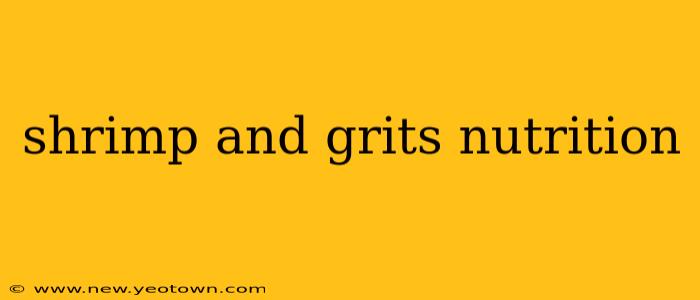Shrimp and grits, a Lowcountry culinary classic, isn't just a delicious dish; it's a surprisingly nutritious meal when prepared thoughtfully. This comforting Southern staple offers a blend of protein, complex carbohydrates, and essential vitamins and minerals. But let's delve deeper than just a simple nutritional breakdown. Let's explore the nutritional profile of this beloved dish, addressing some common questions along the way.
What are the nutritional benefits of shrimp and grits?
The nutritional benefits of shrimp and grits depend heavily on the ingredients and preparation methods. Imagine this: a perfectly cooked plate, where succulent, juicy shrimp are nestled atop creamy, cheesy grits. This isn't just a feast for the senses; it's a nutritional powerhouse!
The shrimp itself is low in calories and fat but high in protein, essential for building and repairing tissues. It's also an excellent source of selenium, a powerful antioxidant, and vitamin B12, crucial for nerve function and red blood cell formation.
The grits, made from ground corn, provide complex carbohydrates, offering sustained energy release, unlike refined sugars. These carbohydrates also contribute dietary fiber, aiding in digestion and promoting gut health. However, the nutritional value of grits can vary depending on whether they are stone-ground or quick-cooking, and whether cheese, butter, or cream is added. A simpler preparation will usually boast a lower calorie and fat content.
How many calories are in a serving of shrimp and grits?
The calorie count of shrimp and grits can fluctuate wildly depending on the recipe. A simple dish with minimal additions might clock in around 300-400 calories per serving. However, a richer version, laden with cheese, butter, and cream, could easily exceed 600-700 calories. The portion size also significantly impacts the overall calorie count.
Is shrimp and grits healthy?
The healthiness of shrimp and grits isn't a simple yes or no answer. It's a matter of balance and mindful preparation. A shrimp and grits dish prepared with lean shrimp, whole-grain grits, and minimal added fats and cheeses can form part of a healthy, balanced diet. It provides essential nutrients, including protein, carbohydrates, and some vitamins and minerals. However, a heavily processed and creamy version is likely to be higher in saturated fat, sodium, and calories, potentially impacting overall health negatively.
What are the ingredients in shrimp and grits?
The basic ingredients are shrimp and grits—cornmeal cooked into a creamy porridge. Beyond this foundation, the possibilities are endless. Recipes frequently incorporate cheese (cheddar, Parmesan, or a blend), butter, cream, bacon or sausage, onions, garlic, peppers, and various herbs and spices.
Are shrimp and grits gluten-free?
Generally, yes, shrimp and grits are naturally gluten-free, provided the grits are made from pure cornmeal and no gluten-containing ingredients are added during preparation. However, always check the ingredient labels of any pre-packaged grits to be certain. Cross-contamination in restaurant settings is also a possibility to be aware of if you have celiac disease or a gluten sensitivity.
How to make shrimp and grits healthier?
Making shrimp and grits healthier involves mindful ingredient choices and preparation techniques. Opt for whole-grain grits instead of instant versions for added fiber. Use lean shrimp and reduce the amount of butter, cheese, and cream to lower the fat and calorie content. Increase the volume of vegetables for added nutrients and fiber, such as sautéed bell peppers and onions, spinach, or mushrooms.
In conclusion, shrimp and grits can be a nutritious and satisfying meal, but the key is balance and thoughtful preparation. By focusing on fresh, whole ingredients and making smart substitutions, you can enjoy this Southern classic without sacrificing your health goals. Remember to consider portion size and be aware of the potential for high fat and sodium content in some recipes.

